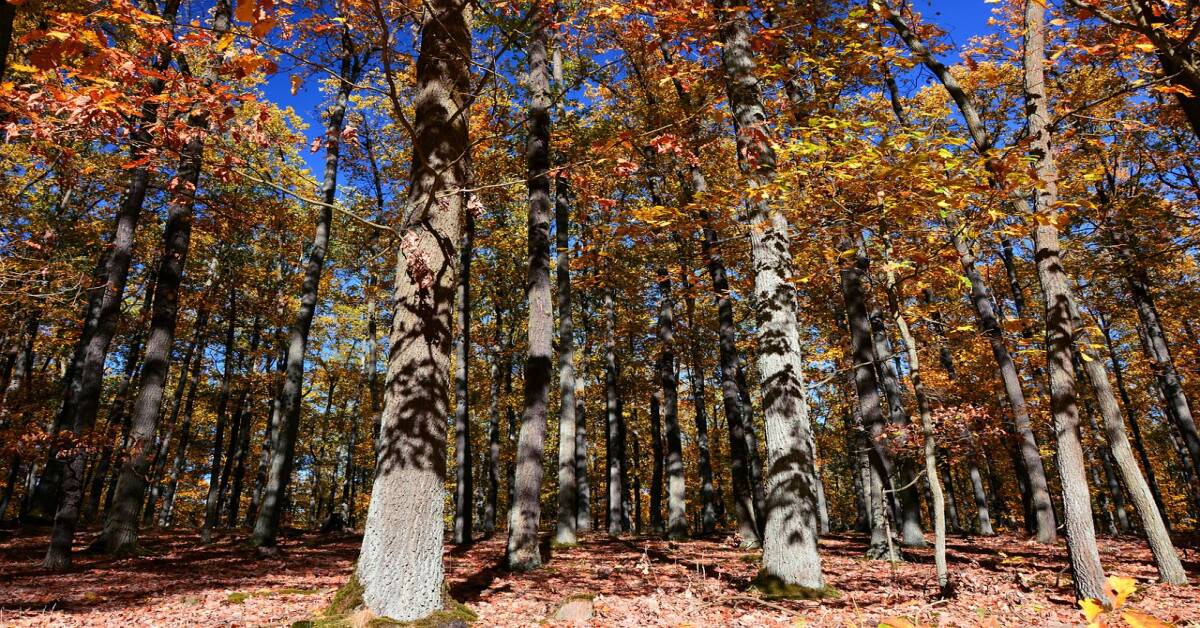Forests in India play a crucial role in maintaining ecological balance. They support diverse flora and fauna and provide resources for millions. Different forest types in India, ranging from tropical rainforests to alpine forests, showcase the country’s rich biodiversity.
Understanding the variety of forests in India is essential. Each type has unique characteristics and serves specific ecological functions. This knowledge helps in appreciating their importance and the need for conservation.
This guide will cover the major forest types in India, explaining their features and significance. “A Guide to the Different Forest Types Found in India” aims to provide a clear understanding of the diverse forest ecosystems and their vital roles.
How Many Types of Forest are Found in India?
India is home to a vast range of forest types, each with its own unique ecosystem. According to the Forest Survey of India, there are six primary types of forests.
These include tropical evergreen, tropical deciduous, tropical thorn, montane, swamp, and littoral and swamp forests. Each forest type supports a diverse array of plant and animal species.
The Different Types of Forests in India cover approximately 24% of the country’s geographical area. Tropical deciduous forests are the most widespread, making up about 40% of the forested area.
In contrast, tropical evergreen forests, found in regions with heavy rainfall, make up a smaller percentage but are rich in biodiversity.
Montane forests are typically located in mountainous regions like the Himalayas, where the altitude influences the vegetation. Swamp and littoral forests are found in coastal and riverine areas. These forests play a crucial role in maintaining ecological balance and supporting wildlife.
How are Forests Classified in India?
Forests in India are classified based on several criteria, including climate, topography, and vegetation. Climate plays a crucial role, as temperature and rainfall patterns determine the types of plants that can thrive.
For example, tropical forests receive high rainfall and have a warm climate, while montane forests are found in cooler, high-altitude areas.
Topography also influences forest classification. In India, forests are found in plains, hills, and coastal regions. Each topographical feature supports different types of forests.
Vegetation is another key factor, as the dominant plant species in an area help to categorize the forest type. For instance, deciduous forests shed their leaves seasonally, whereas evergreen forests remain green throughout the year.
The classification system used in India groups forests into six main types: tropical evergreen, tropical deciduous, tropical thorn, montane, swamp, and littoral and swamp forests.
Each type has distinct characteristics and supports diverse ecosystems. Understanding these classifications helps in the conservation and management of these vital natural resources.
Major Types of Forests in India
Major types of forests in India are:
Tropical Evergreen Forests
Tropical evergreen forests are dense and lush, with trees that remain green all year round. These forests receive high rainfall, typically over 200 cm annually, and have a warm climate with little seasonal variation. The dense canopy allows limited sunlight to reach the forest floor, creating a unique ecosystem.
Major locations of tropical evergreen forests in India include the Western Ghats, the Andaman and Nicobar Islands, and parts of northeastern states like Arunachal Pradesh.
These regions provide the ideal conditions for these forests to thrive. The Western Ghats, in particular, are renowned for their rich biodiversity and are considered one of the world’s biodiversity hotspots.
The key flora of tropical evergreen forests includes tall trees such as teak, mahogany, and rosewood. These trees often reach heights of up to 60 meters. The forests are also home to various plant species, including orchids and ferns.
Fauna includes a diverse range of animals, such as elephants, tigers, leopards, and several species of birds and insects. The rich biodiversity of these forests makes them critical for conservation efforts.
Tropical Deciduous Forests
Tropical deciduous forests, also known as monsoon forests, are characterized by trees that shed their leaves seasonally. These forests experience distinct wet and dry seasons.
During the dry season, trees lose their leaves to conserve water, and in the wet season, they regrow lush foliage. This adaptation helps them survive in regions with moderate rainfall.
There are two subtypes of tropical deciduous forests:
- Moist Deciduous Forest
- Dry Deciduous Forest
Moist deciduous forests receive more rainfall, typically between 100 to 200 cm annually. Dry deciduous forests receive less, usually between 50 to 100 cm annually. Moist deciduous forests have a denser canopy, while dry deciduous forests have a more open canopy and less undergrowth.
Major locations of tropical deciduous forests in India include the central and southern regions. Moist deciduous forests are found in states like Kerala, Odisha, and parts of the Western Ghats.
Dry deciduous forests are common in Madhya Pradesh, Uttar Pradesh, and Karnataka. These forests cover vast areas and are crucial for wildlife habitats and local communities.
Key flora of tropical deciduous forests includes teak, sal, and bamboo. These trees provide valuable timber and other resources. Fauna includes a wide range of animals like deer, elephants, and tigers.
Birds such as peafowls, hornbills, and woodpeckers are commonly found in these forests. The diverse plant and animal life in tropical deciduous forests contribute significantly to India’s ecological richness.

Tropical Thorn Forests
Tropical thorn forests are characterized by their sparse, open canopy and thorny vegetation. These forests are adapted to arid and semi-arid conditions with low rainfall, typically between 25 to 75 cm annually.
The trees and shrubs in these forests have thick, small leaves or spines to reduce water loss, making them well-suited to withstand drought.
Major locations of tropical thorn forests in India include the states of Rajasthan and Gujarat. These regions experience harsh climatic conditions with high temperatures and low rainfall. The thorn forests in these areas are crucial for preventing soil erosion and supporting unique wildlife adapted to dry environments.
Key flora in tropical thorn forests includes acacia, babul, and cacti. These plants have deep root systems and can survive with minimal water. The fauna in these forests is equally adapted to the harsh conditions.
Animals such as blackbucks, Indian gazelles, and desert foxes are commonly found here. Bird species like the Indian bustard, quails, and sandgrouse are also typical inhabitants.
The adaptation of both flora and fauna to the challenging environment highlights the resilience of life in tropical thorn forests.
Also Read: The Enchanting World of Tropical Deciduous Forest Trees
Montane Forests
Montane forests are characterized by their location in high-altitude regions and cooler climates. These forests typically experience significant rainfall, contributing to their lush vegetation.
The diversity of plant and animal life in montane forests is remarkable, adapting to the varying conditions found at different elevations.
There are two primary subtypes of montane forests:
- Montane Wet Temperate
- Montane Dry Temperate
Montane Wet Temperate forests thrive in areas with high rainfall and frequent mist. These forests are dense and filled with mosses, ferns, and broad-leafed trees like oaks.
Montane Dry Temperate forests, found in regions with less rainfall, are more open and dominated by coniferous trees like pines and firs.
Major locations of montane forests in India include the Himalayan range and parts of the Western Ghats. In the Himalayas, these forests span elevations from 1,500 to 3,500 meters. The Western Ghats also host extensive montane forests, contributing to their status as a biodiversity hotspot.
Key flora in montane forests includes rhododendrons, which are prominent in the Himalayas, and evergreen trees like spruce and cedar. The fauna is equally diverse, with notable species such as the snow leopard, Himalayan black bear, and red panda.
Birdlife includes species like the monal pheasant, Himalayan vulture, and various finches. The rich biodiversity of montane forests underscores their ecological importance.
Swamp Forests
Swamp forests, also known as freshwater swamp forests, are wetlands dominated by trees and shrubs. These forests are typically found in areas with standing or slow-moving water, creating a unique ecosystem that supports a wide range of plant and animal life.
The waterlogged conditions are ideal for certain types of vegetation that thrive in wet, swampy environments.
Major locations of swamp forests in India include the Sundarbans and Kerala. The Sundarbans, located in the delta region of the Ganges, Brahmaputra, and Meghna rivers, is one of the largest and most famous swamp forests.
Kerala’s Vembanad Lake region also hosts significant swamp forest areas, contributing to the state’s rich biodiversity.
Key flora in swamp forests includes mangroves, which are particularly abundant in the Sundarbans. These trees have specialized roots that allow them to survive in waterlogged soil.
Other common plants include water lilies and reeds. The fauna in swamp forests is diverse, with species like the Bengal tiger, found in the Sundarbans, and various reptiles such as crocodiles and water snakes.
Bird species such as kingfishers, herons, and egrets are also commonly seen in these habitats. The unique environment of swamp forests supports a rich array of wildlife, making them crucial for biodiversity conservation.

Littoral and Swamp Forests
Littoral and swamp forests are coastal wetlands characterized by their mix of saltwater and freshwater influences. These forests thrive in regions where tides and rivers meet, creating a unique ecosystem.
The soil is often waterlogged, and the vegetation is adapted to saline conditions and frequent flooding.
Major locations of littoral and swamp forests in India include coastal regions like the Sundarbans, the Andaman and Nicobar Islands, and parts of Kerala. These areas provide the perfect environment for these forests to flourish.
The Sundarbans, in particular, is renowned for its extensive network of tidal waterways and swampy terrain.
Key flora in littoral and swamp forests includes mangroves, palms, and a variety of salt-tolerant plants. Fauna includes species like the Bengal tiger in the Sundarbans, saltwater crocodiles, and various fish and crustaceans.
Bird species such as herons, egrets, and kingfishers are common, taking advantage of the rich feeding grounds provided by these ecosystems. The diverse plant and animal life in littoral and swamp forests make them essential for maintaining coastal biodiversity.
Mangrove Forests
Mangrove forests are coastal woodlands found in tropical and subtropical regions. These forests are characterized by salt-tolerant trees and shrubs with complex root systems that stabilize the shoreline and reduce erosion.
Mangroves play a critical role in protecting coastal areas from storm surges and tsunamis.
Major locations of mangrove forests in India include the Sundarbans, the Andaman and Nicobar Islands, and the coastal regions of Gujarat and Maharashtra.
The Sundarbans is the largest mangrove forest in the world, spanning India and Bangladesh. The Andaman and Nicobar Islands also have extensive mangrove coverage, supporting rich biodiversity.
Key flora in mangrove forests includes mangrove species like Rhizophora, Avicennia, and Sonneratia. These trees have specialized roots that allow them to thrive in saline, waterlogged conditions.
Fauna includes species such as the Bengal tiger, saltwater crocodiles, and various fish and shellfish that use the mangrove roots as nurseries.
Birdlife is abundant, with species like kingfishers, herons, and ospreys commonly seen. Mangrove forests are vital for coastal protection and biodiversity, supporting a wide range of wildlife.
Importance of Different Forest Types
Different forest types in India are crucial for maintaining ecological balance. They regulate the climate, purify the air, and control soil erosion. Forests also play a key role in the water cycle, ensuring that water bodies are replenished and maintained.
By providing habitats for numerous species, forests contribute to the stability and health of ecosystems.
The economic value of forests is significant. They provide resources such as timber, bamboo, and medicinal plants. For example, tropical deciduous forests supply valuable timber like teak and sal.
Forests also support livelihoods through activities like ecotourism, which generates income for local communities. In addition, forests contribute to agriculture by providing non-timber forest products like fruits, nuts, and honey.
Forests are vital for biodiversity conservation. They house a vast array of plant and animal species, many of which are endemic or endangered.
Different types of forests, such as tropical evergreen and montane forests, offer unique habitats that support diverse life forms. By preserving forests, we protect these species and ensure the survival of the planet’s biodiversity.
Threats to Forests in India
Forests are important as they play several vital roles, but they face several threats such as deforestation, climate change, and human activities.
Deforestation is one of the most pressing issues, driven by the need for agricultural land, urbanization, and logging. This leads to habitat loss for many species and disrupts the ecological balance.
Climate change poses another significant threat to Indian forests. Changes in temperature and rainfall patterns can alter forest composition and health. For example, increased temperatures can make forests more susceptible to pests and diseases.
Additionally, extreme weather events, such as cyclones and floods, can cause widespread damage to forest ecosystems.
Human activities also contribute to the degradation of forests. Illegal logging, mining, and infrastructure development often encroach on forested areas, leading to fragmentation and loss of biodiversity.
Overgrazing by livestock can further degrade the land, making it difficult for forests to regenerate. Addressing these threats is essential to ensure the long-term health and sustainability of India’s forests.
Conservation Efforts and Sustainable Practices
Forests are important and need conservation efforts. These efforts include government policies and initiatives, the role of NGOs and community involvement, and sustainable forestry practices. Government policies and initiatives play a crucial role in forest conservation.
The Indian government has enacted laws such as the Forest Conservation Act and established protected areas like wildlife sanctuaries and national parks. These measures help safeguard forests from deforestation and illegal activities.
The role of NGOs and community involvement is also vital in conserving forests. NGOs work to raise awareness, provide education, and implement conservation projects.
They often collaborate with local communities to promote sustainable practices and empower them to protect their natural resources. Community involvement ensures that conservation efforts are grounded in local knowledge and are more sustainable in the long term.
Sustainable forestry practices are essential for maintaining forest health and productivity. These practices include selective logging, which minimizes environmental impact, and agroforestry, which integrates trees with agricultural crops.
By adopting sustainable methods, we can ensure that forests continue to provide ecological, economic, and social benefits for future generations. Through combined efforts, we can effectively protect and conserve India’s diverse forest ecosystems.
Conclusion
In this guide to the different forest types found in India has highlighted the variety and significance of these ecosystems. From tropical evergreen to montane forests, each type plays a crucial role in maintaining biodiversity and ecological balance.
Preserving the different forest types in India is essential for environmental health, economic resources, and cultural heritage.
Final thoughts emphasize the need for ongoing conservation efforts to protect these vital ecosystems. By understanding and valuing India’s diverse forests, we can ensure their survival for future generations.
For further reading, consider sources like “Indian Forestry: A Perspective” by K. Manohar Rao, and journals such as the “Indian Journal of Forestry” and “Journal of Tropical Forest Science.” These provide deeper insights into forest conservation and management practices.






